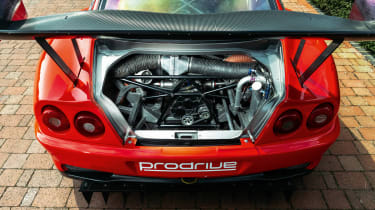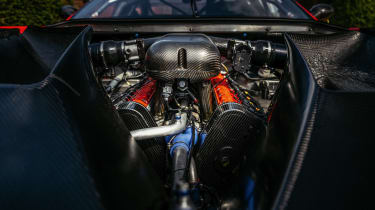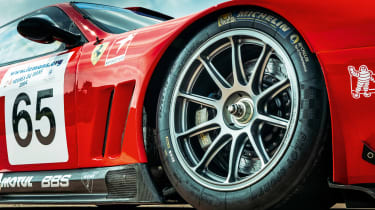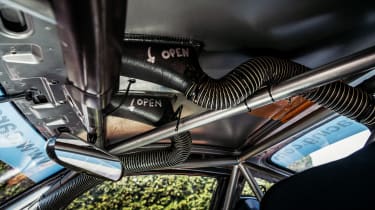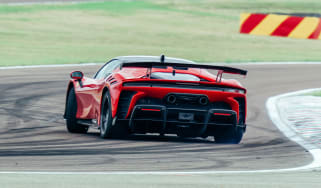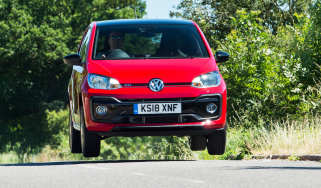Ferrari 550 Maranello Prodrive: the anatomy of a Le Mans GT car
The Prodrive 550 Maranello was the most successful GT racer of the early noughties – and the last V12 Ferrari to score a class win at Le Mans
Few combinations in motorsport history are more evocative than ‘Ferrari’ and ‘Le Mans’. The company made its name there, in part, by winning the first post-war race in 1949, and Enzo Ferrari considered a good performance by his cars in the 24 Hours vital throughout the ’50s, ’60s and into the early ’70s. From there the marque played more of a supporting role, with Daytonas and then Berlinetta Boxers in the GT class; when it returned for outright glory it was as an engine supplier to the factory Lancia squad in the Group C era of the 1980s.
When Group C fizzled out in the early ’90s, GT cars returned to front sportscar racing as a more affordable, privateer-based formula, and early contenders included 348-based and then F355 racing machines, as well as crowd-pleasing F40s at the front of the field. However, as the emergent BPR series and the Le Mans 24 Hours evolved into the FIA-run World GT Championship, the recipe soon soured, first after Porsche’s appearance with the 911 GT1, and then Mercedes-Benz with the CLK GT1. In particular, the Merc, effectively a pure racing car and backed by a colossal budget, was beyond what any rival factory team or privateer squad could afford to compete against. Even Ferrari, who had begun development of an F50-based GT1 contender, was deterred from a direct confrontation and quietly sold off the F50 test cars.
So for 1999 the short-lived GT1 category would be axed, and the GT Championship effectively run with GT2-spec cars as its premier category. For series promoter Stéphane Ratel and his SRO company – the former the ‘R’ in the BPR series – running an international championship with little more than Dodge Vipers and turbocharged 911s at the front of the field was not appealing. Ratel went on the offensive, arguing to the FIA that rather than waiting for manufacturers to homologate cars for racing, teams should be able to apply for a technical passbook for a particular vehicle, effectively a reversal of the traditional procedure. The FIA agreed and, after drawing up a list of viable cars, gave manufacturers 15 days to protest against their inclusion.
What Ratel and his investors really wanted, though, was a Ferrari towards the front of the grid, and the firm’s flagship of the time, the 550 Maranello, fitted the big GT car template perfectly. Which is why in early 2000 a project to develop the 550 into a GT machine was begun at Turin-based engineering firm Italtecnica, the car being known as the 550 Millennio. Developed in double-quick time, it featured an enlarged, 6-litre V12, hit the minimum weight limit at 1100kg, and looked as formidable as it sounded.
Sadly, the results in that 2000 season, or rather the lack of them, suggested it was anything but formidable, the 550 suffering in particular from dismal reliability. One of the project’s backers was French industrialist Frédéric Dor, who had long campaigned rally cars prepared by Prodrive, including in 1999 a Subaru Impreza WRC that the year before had been one of Colin McRae’s regular mounts. With one eye on the car’s hitherto poor results, Dor shipped his 550 to Banbury before it had even turned a wheel in anger, and the prognosis from Prodrive’s George Howard-Chappell was not encouraging. To put it bluntly, if it was to have Prodrive’s name on it, they’d rather start from scratch thank you very much. Which is where the Prodrive 550 project really began.
Complicating the task, sportscar racing was going through one of its significant periods of change, and emerging from the entanglement came two significant power bases: the FIA-sanctioned GT Championship, but also the American Le Mans Series (ALMS) in partnership with the ACO (Automobile Club de l’Ouest – the Le Mans 24 Hours organiser and promoter of the European-based Le Mans Series), which meant that cars racing Stateside and at Le Mans ran to a slightly different rule-set depending on where they were racing. This meant that teams had to test and develop subtly different permutations of their cars if they wanted to be competitive in both championships.
Prodrive chassis 03
The first two chassis built by Prodrive were created from left-hand-drive road cars purchased by Prodrive’s then technical director (and also later team principal) George Howard-Chappell from a dealer on London’s Kings Road. The car you see here, chassis 03, is arguably even more special.
Currently co-owned by Max Girado of Girado & Co and James Cottingham of DK Engineering, it started life as Dor’s road car – the same road car in which he’d driven to the Ferrari factory for an ultimately unsuccessful meeting with Jean Todt to try and convince Ferrari to make a factory 550 racer. Dor then provided it to Prodrive when they wanted to build up a third chassis; the company would eventually construct 12 cars – ten racers and two test and development cars.
Chassis 03’s biggest claim to fame is its extraordinary participation at Le Mans, where it competed an amazing five times (2002, ’03, ’04, ’05 and ’06) – the most appearances an individual Ferrari chassis has ever achieved at La Sarthe – perhaps most memorably when Colin McRae joined Rickard Rydell and Darren Turner for the 2004 running of the race, the trio finishing third in class. Recently the car has returned to the track, and it is also the star of a new book on the Prodrive 550 Maranello GT cars (available from girardo.com), from which a good deal of info for this story was gleaned.
Body, structure & aero
While GT regulations at the time allowed for substantial changes to a donor car, the fundamentals still remained very much in place. In the case of the 550, this was largely good news. It had a large-capacity engine of sophisticated design and, crucially, the gearbox was a transaxle unit (rear mounted), not up at the engine end, to the great benefit of weight distribution and traction. Double-wishbone suspension was ideal for a racing car, and the body design presented pleasingly low air resistance when viewed from the front. Large overhangs front and rear promised plenty of space for the crucial additional aerodynamic elements to do their stuff.
‘The championship-winning [2000] Mondeo touring car we’d built for Ford was a beautiful racing car made from a road car, and that was the standard we were after,’ says Howard-Chappell today, reflecting on why the Italtecnica machine was never going to be good enough for them. ‘The Ford BTCC project positioned us from an engineering and design point of view to make a car like the 550.’
Still, as he notes, it wasn’t another McLaren F1, neither did it have the inherent benefits of a Saleen S7R, one of the 550’s rivals and a mid-engined car virtually purpose-built for the track.
In light of that, getting the 550’s weight distribution and centre of gravity as balanced and low as possible was vital. The engine was extensively lightened, via its internals and also by binning the variable intake system (worth 20kg alone), while a dry sump set-up allowed it to be positioned much lower in the car. It was then moved back towards the bulkhead as far as possible, even to the point where the cam covers were cut away on the ends and a new steering rack had to be run between the cam belts drive and engine block to find a path to the front wheels. The original steel monocoque centre section was extensively strengthened by a substantial roll-cage, which not only provided the required crash protection but gave the car the majority of its required rigidity.
Due to the tight deadlines, there was no scale-model wind-tunnel testing. A limited full-scale programme was carried out at MIRA, checking rear wing designs and the overall shape, but the front splitter and underbody aero could only be developed on the track with a moving road underneath. Nevertheless, this was the era when teams could still develop their cars as they saw fit, and Prodrive would evolve the aerodynamic package of the 550, as they did many other details on the car. When setting it up for a race, the angle of the front splitter, along with the car’s ride height and subsequent underbody aero effectiveness, were crucial to its overall performance.
Yet Dor still wasn’t quite satisfied. He wanted his racing Ferrari to look beautiful – like a factory-built racing Ferrari in the finest tradition, so Prodrive boss David Richards approached Peter Stevens to finesse the package that the engineers had come up with. ‘I was doing lots of work for Prodrive so David asked me to take a look,’ recalls Peter today. ‘I felt it was important that it looked like a Ferrari – that it didn’t just have a race car look imposed upon it; there’s no excuse for racing cars not looking good. It’s a big car, so I didn’t want it to look even bigger, and I wanted it to look voluptuous. We did a clay model, and even took great care with the air intakes to get them looking right.’
Engine & transmission
GT rules decreed that the block and head castings remained the same as on the road car, and that the engine had to breathe through an air restrictor that limited power to what the organisers hoped would be around 600bhp. Once inside the engine, Prodrive’s engineering team found the design and quality of components to be extremely high – so much so that the steel crankshaft and titanium rods of the Maranello were initially retained. To negate the effects of the restrictor as much as possible, the displacement was stretched to 5853cc (from the road car’s 5474cc), but the cylinder head received a lot more attention and the valvetrain was entirely new. For added complication, the FIA rules insisted on the same material here as the road car, whereas the ACO/ALMS regs allowed titanium to be introduced.
In FIA GT spec, the car was originally raced with a 32.1mm restrictor, which soon shrank to 31.6mm at the next race, and then 31.1mm after the car showed dominant form. After that, the FIA insisted the airbox was redesigned, despite not deeming it illegal; the ACO, meanwhile, didn’t have a problem with it.
For Le Mans in 2002 the displacement of the V12 was increased to 5983cc through enlarging the bore to 92mm and there was a whole host of other improvements. This spec of engine was good for at least 600bhp and 553lb ft of torque.
The final spec change came much later, with an ‘EVO’ engine known as the ‘low cost engine’. It ran on normal fuel and used standard cylinder heads and a simpler airbox design, all with a view to cutting costs and increasing mileage. It’s one of these engines that currently sits in ‘03’ today as you see in our photos, which explains why the glorious full carbon airbox and individual butterfly throttles of the original engine are absent.
The road car’s six-speed synchro gearbox was replaced with a six-speed sequential racing ’box designed by Xtrac. However, the ACO initially demanded H-pattern manual ’boxes, so as with many other detail items, the car had to be reconfigured for those races. The original Prodrive design had the ’box installed transversely, which the FIA didn’t approve of, so a longitudinal layout was adopted.
For the time, the 550’s Pi Research ECU, data-logging and electronic display were cutting edge, but, like its traction control set-up, are obviously crude compared with the sophistication of modern electronics. The sequential gearbox had a flat-shift facility enabled by an optical sensor on the back of the gearlever.
suspension, tyres & brakes
The Prodrive 550s used Koni fully adjustable racing dampers. Early cars had unassisted steering, but electric power assistance was adopted later. The 550’s double-wishbone suspension was a nice starting point: ‘With the repositioning allowed within the regs we got something pretty decent,’ says Howard-Chappell.
The team started on Dunlops, but after a couple of race wins switched to Michelins and ran on them from that point. Iron discs were run in the FIA GT series, but ACO rules allowed carbon brakes.
Driving the 550M
Darren Turner was driving the British Team Veloqx Ferrari 360 when he stepped into Prodrive’s 550 at Sebring in 2003. He wasn’t to know then, but it would be the beginning of a relationship that’s lasted 18 years and counting. ‘I’d had two years in the DTM before that,’ recounts Turner today, ‘so I was used to decent power. But the nice thing was, although the 550 looks a beast, it’s really driver- friendly; by the time I got to the car it felt like a seasoned racing car, and I was fully confident within ten laps and up to the speed of the regular drivers. Those races at Sebring and then Miami in ’03 put me where I am today.
‘To drive, it was more point-and-squirt than the GTE cars now. It had lots of power, plenty of downforce; more driver involvement than today. You’d heel-and-toe with the sequential ’box, and use the clutch on the way down when driving in the wet. It was very rewarding to drive and you could trust it. Joyous, really.
‘It did get really warm in there though, especially during races in hot climates. We’d use cool-vests, with a big tank of ice alongside you, but then racing was more difficult then. There was traction control by the time I drove it, but you’d leave it off for qualifying: it was crude, and you were more likely to use it for protecting the tyres in a race, minimising the lateral loads on the rear tyres.
‘The highlight of those years for me was sharing the car with Colin at Le Mans in 2004 [the line-up of Turner, Rickard Rydell and rally megastar Colin McRae finished third in class that year]. Meeting him for the first time was a big deal, but he was so laid- back, he listened, he was just one of the boys.
‘Unlike now, we stayed at an old chateau near the circuit, and I remember walking out to the pool and thinking, “This is so cool, all of us enjoying the company of each other.” It was like racing in the ’60s and ’70s I suppose. It’s a great memory.’
Racing history
The first season, 2001, was very much a development year for the Prodrive 550s, with three rounds of the FIA GT Championship and one ALMS round. The following year a single Prodrive 550 entered Le Mans, but while it may have retired on lap 175, it qualified on class pole and took fastest lap in the race – a clear warning of its speed to the class-dominant Corvettes and Vipers. The FIA GT Championship was contested by BMS Scuderia Italia and the factory Care Racing teams, with BMS earning 4th overall by the end of the year, while three rounds Stateside netted fifth overall in the ALMS.
It really came together in 2003, with the dream GTS class win at Le Mans for Peter Kox, Tomas Enge and Jamie Davies, who also scooped class pole and finished 10th overall. BMS Scuderia Italia were also FIA GT champions that year (including the class win at the 24 hours of Spa), while Prodrive fought an epic battle in the ALMS against the factory Corvettes, narrowly missing out on the GTS title.
By 2004, the Saleen S7R was becoming a formidable opponent, Ferrari’s factory-blessed 575 GTC was also in ascendancy, and the Maserati MC12 made its debut. However, 3rd in class at Le Mans, another FIA GT championship for the BMS team along with the drivers’ title for the team’s Luca Cappellari was a measure of the Prodrive 550’s class and staying power. Labre Competition’s 550 won the inaugural Le Mans Series in Europe.
Prodrive’s focus had switched to all things Aston Martin by 2005, but its 550s continued to compete in private hands, with 4th and 5th in class at Le Mans for Larbre and Cirtek Motorsport respectively. Larbe managed another drivers’ championship crown in FIA GT with Gabriele Gardel, and third overall as a team behind the Maseratis, while BMS took the Le Mans Series. By 2006, the car was in the twilight of its career, but still a capable machine in the hands of privateer teams, and always a thrilling sight on the track.
Postscript
With the benefit of hindsight, the early noughties were a classic time for sportscar racing. These were big, powerful cars, and racing wasn’t controlled by a Balance of Performance judgement in the paddock. As George Howard-Chappell says: ‘You homologated the basic car, but you could change stuff and develop it. It was great fun. Those were the days when if you weren’t fast enough you went home and worked on your car, you didn’t look to change the BOP. Many of the guys still work with me now, and they often say 2003 was one of the best years of their racing life, and it was. It was great.’
A number of teams tried to develop a racer based on the 550, but even Ferrari’s factory-backed effort by N Technology and the later 575-based cars couldn’t match the success and longevity of the Prodrive 550. It is, unquestionably, one of the all-time classic endurance racing cars. Sadly, the formula would, in time, suffer the usual cyclic fate of endurance racing; by the beginning of the next decade the top GT category would begin to splinter and decline. The GTE rule-set has provided an ultra-competitive arena in recent years, but the glory days of the big GT/GTS cars are still much missed.



